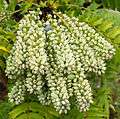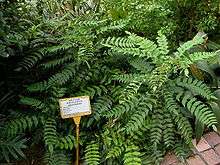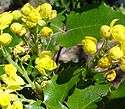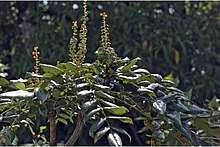Mahonia
Mahonia is a genus of approximately 70 species of evergreen shrubs and rarely small trees in the family Berberidaceae, native to eastern Asia, the Himalaya, North and Central America.[1] They are closely related to the genus Berberis and botanists disagree on whether to recognize a separate Mahonia.[2] Many botanists prefer to classify Mahonia as a part of Berberis[3][4][5][6] because several species in both genera are able to hybridize, and because there are no consistent morphological differences between the two groups other than the leaf pinnation (Berberis sensu stricto appear to have simple leaves, but these are in reality compound with a single leaflet and are termed "unifoliolate"; additionally their branched spines are modified compound leaves[7]). However, a recent DNA-based phylogenetic study retains the two separate genera, by clarifying that unifoliolate-leaved Berberis s.s. is derived from within a paraphyletic group of shrubs bearing imparipinnate evergreen leaves, which the paper then divides into three genera: Mahonia, Alloberberis (formerly Mahonia section Horridae), and Moranothamnus (formerly Berberis claireae); it confirms that a broadly-circumscribed Berberis (that is, including Mahonia, Alloberberis, and Moranothamnus) is monophyletic.[8]
| Mahonia | |
|---|---|
 | |
| Mahonia aquifolium fruit | |
| Scientific classification | |
| Kingdom: | Plantae |
| Clade: | Tracheophytes |
| Clade: | Angiosperms |
| Clade: | Eudicots |
| Order: | Ranunculales |
| Family: | Berberidaceae |
| Genus: | Mahonia Nutt. |
| Type species | |
| Mahonia aquifolium | |
| Species | |
Mahonia species bear pinnate leaves 10–50 cm (3.9–19.7 in) long with 3 to 15 leaflets, and flowers in racemes which are 5–20 cm (2.0–7.9 in) long. Several species are popular garden shrubs, grown for their ornamental, often spiny, evergreen foliage, yellow (or rarely red) flowers in autumn, winter and early spring, and blue-black berries. The flowers are borne in terminal clusters or spreading racemes, and may be among the earliest flowers to appear in the growing season.[9] The berries are edible, and rich in vitamin C, though with a very sharp flavor.[10] Although edible, the plants contain berberine, a compound found in many Berberis and Mahonia species, which can cause vomiting, lowered blood pressure, reduced heart rate, lethargy, and other ill effects when consumed in large quantities.[10]
The genus name, Mahonia, derives from Bernard McMahon, one of the stewards of the plant collections from the Lewis and Clark expedition. The type species of the genus is M. aquifolium.[8]
Species
The following list includes all currently recognized species of the genus Mahonia as accepted by Tropicos, Missouri Botanical Garden as of February 2016, sorted alphabetically. For each, binomial name is followed by author citation.[11][12]
- Mahonia aquifolium (Pursh) Nutt.
- Mahonia bealei (Fortune) Carrière
- Mahonia bodinieri Gagnep.
- Mahonia bracteolata Takeda
- Mahonia breviracema Y.S. Wang & P.G. Xiao
- Mahonia cardiophylla T.S. Ying & Boufford
- Mahonia decipiens C.K. Schneid.
- Mahonia duclouxiana Gagnep.
- Mahonia eurybracteata Fedde
- Mahonia fordii C.K. Schneid.
- Mahonia fortunei (Lindl.) Fedde
- Mahonia fremontii (Torr.) Fedde
- Mahonia gracilipes (Oliv.) Fedde
- Mahonia hancockiana Takeda
- Mahonia imbricata T.S. Ying & Boufford
- Mahonia japonica (Thunb.) DC.
- Mahonia leptodonta Gagnep.
- Mahonia longibracteata Takeda
- Mahonia leschenaultii Wall. Ex. Wight & Arn.
- Mahonia miccia Buch.-Ham. ex D. Don
- Mahonia microphylla T.S. Ying & G.R. Long
- Mahonia monyulensis Ahrendt
- Mahonia moranensis (Schult. & Schult. f.) I.M. Johnstone
- Mahonia napaulensis DC.
- Mahonia nervosa (Pursh) Nutt.
- Mahonia nitens C.K. Schneid.
- Mahonia oiwakensis Hayata
- Mahonia paucijuga C.Y. Wu ex S.Y. Bao
- Mahonia polyodonta Fedde
- Mahonia retinervis P.G. Xiao & Y.S. Wang
- Mahonia setosa Gagnep.
- Mahonia shenii Chun
- Mahonia sheridaniana C.K. Schneid.
- Mahonia subimbricata Chun & F. Chun
- Mahonia taronensis Hand.-Mazz.
- Mahonia tenuifolia (Lindl.) Loudon ex Fedde
- Mahonia tinctoria (Terán & Berland.) I.M. Johnst.
- Mahonia trifoliolata (Moric.) Fedde
- Mahonia volcanica Standl. & Steyerm.
Gallery
 Ripe fruits of Mahonia 'Golden Abundance'
Ripe fruits of Mahonia 'Golden Abundance' Immature fruits of Mahonia oiwakensis subsp. lomariifolia
Immature fruits of Mahonia oiwakensis subsp. lomariifolia Mahonia oiwakensis at Hong Kong Zoological and Botanical Gardens
Mahonia oiwakensis at Hong Kong Zoological and Botanical Gardens Flowers and buds of Mahonia aquifolium
Flowers and buds of Mahonia aquifolium A flowering branch of Mahonia leschenaultii
A flowering branch of Mahonia leschenaultii
References
- Flora of China Vol. 19 Page 772 十大功劳属 shi da gong lao shu Mahonia Nuttall, Gen. N. Amer. Pl. 1: 211. 1818.
- "Mahonia". Germplasm Resources Information Network (GRIN). Agricultural Research Service (ARS), United States Department of Agriculture (USDA).
- "Berberis fremontii in Flora of North America @ efloras.org". www.efloras.org.
- Loconte, H., & J. R. Estes. 1989. Phylogenetic systematics of Berberidaceae and Ranunculales (Magnoliidae). Systematic Botany 14:565-579.
- Marroquín, Jorge S., & Joseph E. Laferrière. 1997. Transfer of specific and infraspecific taxa from Mahonia to Berberis. Journal of the Arizona-Nevada Academy of Science 30(1):53-55.
- Laferrière, Joseph E. 1997. Transfer of specific and infraspecific taxa from Mahonia to Berberis. Botanicheskii Zhurnal 82(9):96-99.
- Pabón-Mora, Natalia; González, Favio (2012). "Leaf development, metamorphic heteroblasty and heterophylly in Berberis s. l. (Berberidaceae)". The Botanical Review. 78 (4): 463–489. doi:10.1007/s12229-012-9107-2.
- Yu, Chih-Chieh; Chung, Kuo-Fang (2017). "Why Mahonia? Molecular recircumscription of Berberis s.l., with the description of two new genera, Alloberberis and Moranothamnus". Taxon. 66 (6): 1371–1392. doi:10.12705/666.6.
- RHS A-Z encyclopedia of garden plants. United Kingdom: Dorling Kindersley. 2008. p. 1136. ISBN 978-1405332965.
- "Mahonia Oregon Grape, Hollyleaved barberry, Oregon Holly Grape, Oregon Holly PFAF Plant Database". www.pfaf.org. Retrieved 2016-02-17.
- "Mahonia". Tropicos. Missouri Botanical Garden. Retrieved 17 February 2016.
- "Mahonia". The Plant List. Missouri Botanical Garden. Royal Botanic Gardens, Kew. Retrieved 17 February 2016.CS1 maint: others (link)
External links
| Wikimedia Commons has media related to Mahonia. |
| Wikispecies has information related to Mahonia |